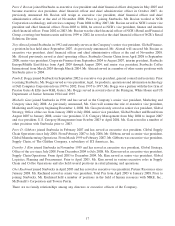Starbucks 2008 Annual Report Download - page 30
Download and view the complete annual report
Please find page 30 of the 2008 Starbucks annual report below. You can navigate through the pages in the report by either clicking on the pages listed below, or by using the keyword search tool below to find specific information within the annual report.
The Company’s International store base continues to increase and Starbucks has been achieving a growing
contribution from established international markets while at the same time investing in emerging markets, such as
China, Brazil and Russia. The Company’s newer international markets require a more extensive support organi-
zation, relative to the current levels of revenue and operating income.
The CPG segment includes packaged coffee and tea as well as branded products operations worldwide. The CPG
segment operates primarily through joint ventures and licensing arrangements with large consumer products
business partners, most significantly The North American Coffee Partnership with the Pepsi-Cola Company for
distribution of ready-to-drink beverages, and with Kraft Foods Inc. for distribution of packaged coffees and teas.
This operating model allows the CPG segment to leverage the business partners’ existing infrastructures and to
extend the Starbucks brand in an efficient way. Most of the customer revenues from the ready-to-drink and
packaged coffee channels are recognized as revenues by the joint venture or licensed business partner, not by the
CPG segment, and the proportionate share of the results of the Company’s joint ventures are included on a net basis
in “Income from equity investees” on the consolidated statements of earnings. As a result, the CPG segment reflects
relatively lower revenues, a modest cost structure, and a resulting higher operating margin, compared to the
Company’s other two reporting segments, which consist primarily of retail stores.
Expenses pertaining to corporate administrative functions that support the operating segments but are not
specifically attributable to or managed by any segment are not included in the reported financial results of the
operating segments. These unallocated corporate expenses include certain general and administrative expenses,
related depreciation and amortization expenses, restructuring charges and amounts included in “Interest income and
other, net” and “Interest expense” on the consolidated statements of earnings.
Acquisitions
See Note 2 to the consolidated financial statements in this 10-K.
RESULTS OF OPERATIONS — FISCAL 2008 COMPARED TO FISCAL 2007
Consolidated results of operations (in millions):
Fiscal Year Ended
Sep 28,
2008
Sep 30,
2007 % Change
Sep 28,
2008
Sep 30,
2007
% of Total Net
Revenues
STATEMENTS OF EARNINGS DATA
Net revenues:
Company-operated retail ..................... $ 8,771.9 $7,998.3 9.7% 84.5% 85.0%
Specialty:
Licensing .............................. 1,171.6 1,026.3 14.2 11.3 10.9
Foodservice and other ..................... 439.5 386.9 13.6 4.2 4.1
Total specialty ............................ 1,611.1 1,413.2 14.0 15.5 15.0
Total net revenues .......................... $10,383.0 $9,411.5 10.3% 100.0% 100.0%
Net revenues for the fiscal year ended 2008 increased due to growth in both Company-operated retail revenues and
specialty operations.
During fiscal 2008, Starbucks derived 84% of total net revenues from its Company-operated retail stores. Company-
operated retail revenues increased, primarily attributable to the opening of 681 new Company-operated retail stores
in the last 12 months, offset by negative 3% comparable store sales for the same period. Revenue growth was slower
than in previous years due to a combination of declining comparable store sales and a decrease in the number of net
new stores opened during fiscal 2008. The weakness in consolidated comparable store sales was driven by the US
segment, which posted a comparable store sales decline of 5% for the year. Partially offsetting this was 2%
comparable store sales growth in the International segment. Within fiscal 2008, consolidated quarterly revenue
24
























